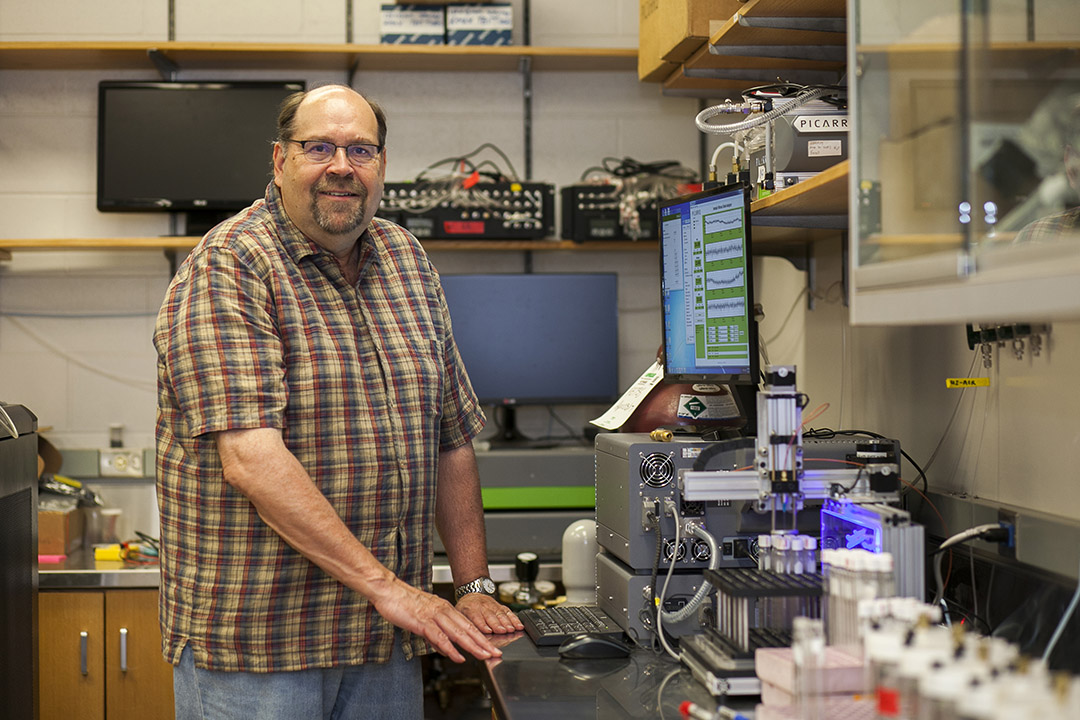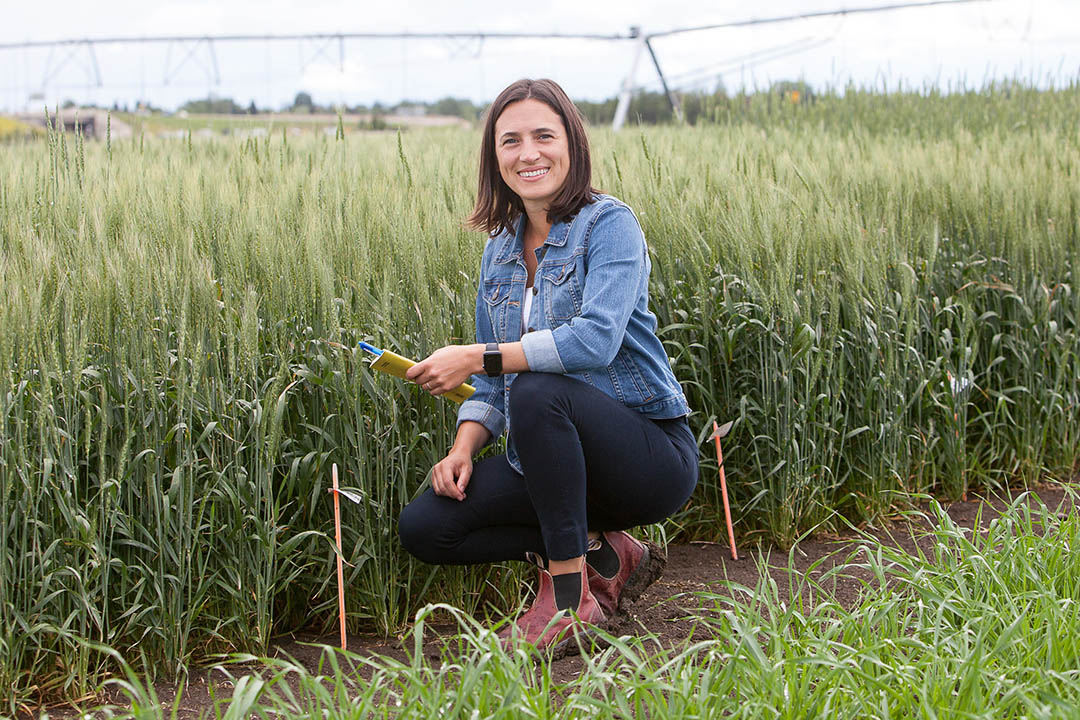
Seeking a holistic understanding of soil health at USask
As the United Nations spotlights World Soil Day on Dec. 5, University of Saskatchewan researchers are investigating soil emissions, soil properties, and how to measure them.
By Joanne PaulsonClimate change is not just about carbon.
As a climate change driver, to be sure, carbon dioxide (CO2) remains a large issue and a constant part of the conversation around reducing greenhouse gas (GHG) emissions.
But particularly for an enormous country like Canada with vast tracts of land that grow food, a wider understanding of how soil health factors into the emissions equation—along with crop production and the economy—is crucial.
Gas emissions other than CO2, such as fertilizer-related nitrous oxide (N2O), have more recently hit the public radar. As recently as 2021, articles in both mainstream and scientific media called N2O “the world’s forgotten greenhouse gas.”
It may not have been the driver of public discourse, but it was not forgotten by the team of soil experts at the University of Saskatchewan (USask).
The team, which includes members of the College of Agriculture and Bioresources (AgBio) as well as the College of Engineering, and the Department of Computer Science in the College of Arts and Science, is bringing together and combining elements from emissions to microorganisms to computer modelling.
Traditionally, the focus of soil research was mainly on fertility, according to Dr. Richard Farrell (PhD), associate professor in the College of AgBio and Ministry of Agriculture Strategic Research Program Chair in Soil Biological Processes.
GHGs then began to come into research exploration with a strong focus on carbon dioxide emissions and sequestration.
Today, USask researchers are evaluating a much bigger picture including various environmental, economic, socioeconomic, and agronomic factors, he said.
Farrell’s own research is focused on greenhouse gas measurements and mitigation. He notes that air quality, water quality and soil quality are all tightly related.
“If soils are poorly managed, you can have runoff; you can have nitrates and phosphates moving into the water. Pollutants can move into the ground water if they’re not properly managed,” he gave as an example.
And when it comes to growing crops, carbon has more of an upside than nitrous oxide.
“Plant growth and crop development are taking carbon out of the atmosphere and pumping it into the soil, so we are sequestering it that way,” Farrell said.
Farrel notes that soils used predominately in agriculture are the major source of nitrous oxide emissions because of the fertilizer used to grow crops.
“Nitrous oxide is a greenhouse gas roughly 265 times more potent in terms of global warming than CO2,” he said.
While farming sequesters tonnes of carbon into the soil, just three and a half kilograms of nitrous oxide offsets one tonne of CO2.
“That’s one of the things we’re looking at: what is this balance between carbon being put into the system and nitrous oxide coming off the system?” said Farrell.
Saskatchewan soils tend to be carbon sinks, and that tendency has been improved by farmers using no-till or minimum-till practices, “so more carbon is going in than is released,” he said. “But nitrous oxide is continuously released from the soil.
“Emissions may not get down to zero, but we want to get them down to background levels, where they would be if we weren’t cropping things.”

Farrell is investigating how to minimize nitrous oxide emissions with Dr. Reynald Lemke (PhD) at Agriculture and Agri-Food Canada, and Dr. Kate Congreves (PhD), an associate professor in the College of AgBio.
Minimum tillage will help, “but we also need to start looking at fertilizer and crop management,” Farrell said.
One form of mitigation already underway is farmers increasingly adding nitrogen-fixing pulse crops such as chickpeas, faba beans and field peas to their rotations.
“(Nitrogen-fixing pulse crops) basically generate 50 to 80 per cent of their entire nitrogen need from atmospheric nitrogen,” Farrell said. “You don’t have to put in nitrogen, or not as much, and consequently in the years you’re growing pulses, nitrous oxide emissions are quite low.
“They also leave nitrogen in the soil, so the crop following needs less nitrogen fertilizer as well.”
Other management tools coming into use are enhanced-efficiency fertilizers. Coated in polymers or sulphur, they slowly release urea fertilizer into the soil. There are also “stabilized” products that include a urease or nitrification inhibitor, or both.
“In dryland systems like in Saskatchewan, we are seeing anywhere from 20 to 40 per cent emissions reductions just by switching to an enhanced efficiency product and in the irrigated systems, we’ve seen even larger emissions reductions, say 40 to 60 per cent or more,” Farrell said.
He has also investigated the effect of shelterbelts on emissions. Trees store a great deal of carbon, and shelterbelts influence an area one and a half times the size of the trees, while having lower emissions than the field.
“(Trees are) storing more carbon and are good places to put carbon,” he said.
“We have to look at these integrated landscapes. A farm will have ponds and shelterbelts and other elements and all of that affects the soil health.”
Congreves, meanwhile, in addition to her work with Farrell, is researching soil health from various perspectives, including measurement.
“We collect samples from all over the province, and the Prairies, and different cropping systems,” she said.
“We’re looking at soil health in a holistic way, including ecosystem and socio-ecological functions. Soil health is not the same as soil fertility. Soil fertility is primarily based in nutrient availability and linked to fertilizer management, whereas soil health encompasses the ecology of the crop production system and surrounding land.”
Her research, focused primarily on cropping systems, looks at conventional and regenerative practices over the whole spectrum—not just large-scale agriculture, but smaller-scale gardens producing fruits and vegetables too.
“We measure carbon-based indicators of soil health, nitrogen-based indicators, and also look at soil life including biological indicators such as microbial biomass, their activity, and stress responses,” she said.
“The goal here is to help growers be stewards of the soil. Soil health assessments help people not just take but give back to the soil. Our research provides soil health metrics that help inform people’s decision-making matrices.”
In practical terms, at the farm or in the garden, producers are interested in collecting soil samples, having them analyzed in the lab, and getting a soil health score card in return. Congreves’ research helps develop and advance these soil health scoring tools.
“These scoring tools take really complex information and soil science data and turn them into an easy-to-understand tool for growers to interpret how their soil might be changing over time and how they can manage it.”
Both Farrell and Congreves say the collaborative team on campus is advancing soil health and its measurement while creating an inspiring atmosphere.
Farrell has been with the university for 27 years and has watched the field evolve. For example, three decades ago, there was little interaction with computer science. That connection has evolved and is making a huge difference today in the era of machine learning and artificial intelligence.
“Now things are much more integrative. I think that’s just a fantastic thing. It’s one of the things I really like about the AgBio college here; everyone wants to work together,” said Farrell.
Congreves is also grateful for the collegiality of the research team as she thinks of the various elements of soil health.
“If you only looked at individual components of soil, you’re not seeing the whole picture. By integrating multiple soil attributes, we can see how well or not the soil is functioning,” she said.
And she notes one other vital role played by the team. Creating a more sustainable future means training the next generation to be mindful of this growing problem and expand this scope of research.
“The most important thing is training students in how to do this. Yes, understanding and modelling soil health is important, but what’s more important is training the next generation of people who will be leaders in it.”
Together, we will undertake the research the world needs. We invite you to join by supporting critical research at USask.

